GT.2 The Physical Earth
Describe Earth’s major physical systems and their characteristics.
Earth is a large system, and it is therefore necessary to divide it into smaller systems to understand how it works. In this section, we examine the interaction between matter and energy, Earth’s physical shape, and Earth’s major physical systems.
Matter and Energy
The flow of energy through Earth’s physical systems is central to most topics in physical geography. Energy is the capacity to do work on or to change the state of matter. Matter is any material that possesses mass and occupies space. Matter can exist in three states: solid, liquid, or gas. To change the state of matter (such as water), energy must be added to or removed from it (Figure GT.7).
energy
The capacity to do work on or to change the state of matter.
matter
Any material that occupies space and possesses mass.
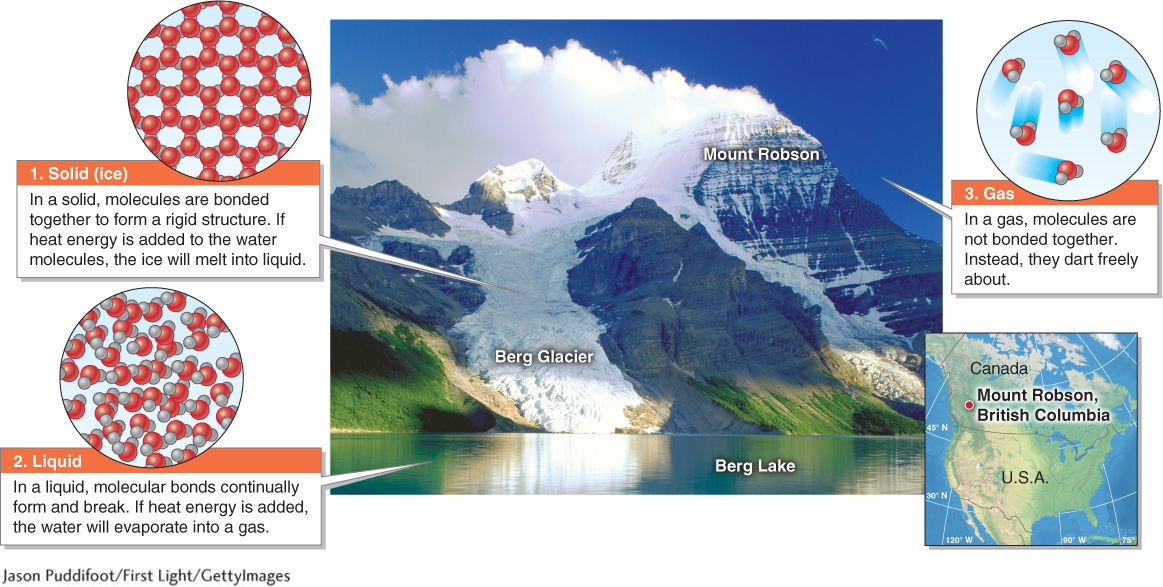
Several forms of energy influence Earth systems. Radiant energy is the energy of electromagnetic waves, such as light or X-
radiant energy
The energy of electromagnetic waves.
photosynthesis
The process by which plants, algae, and some bacteria convert the radiant energy of sunlight to chemical energy.
chemical energy
Energy in a substance that can be released through a chemical reaction.
geothermal energy
Heat from Earth’s interior.
Two other important categories of energy in physical geography are potential energy and kinetic energy (both types of mechanical energy). Potential energy is stored in an object or material. A boulder perched over a cliff about to fall is an example of potential energy. Kinetic energy is the energy of movement. A boulder that is falling down a cliff and smashing into other rocks is an example of kinetic energy.
As energy flows through Earth’s physical systems, it moves matter, and it changes its form in the process. Figure GT.8 examines how the Sun’s radiant energy changes from one form to another in Earth’s physical systems.
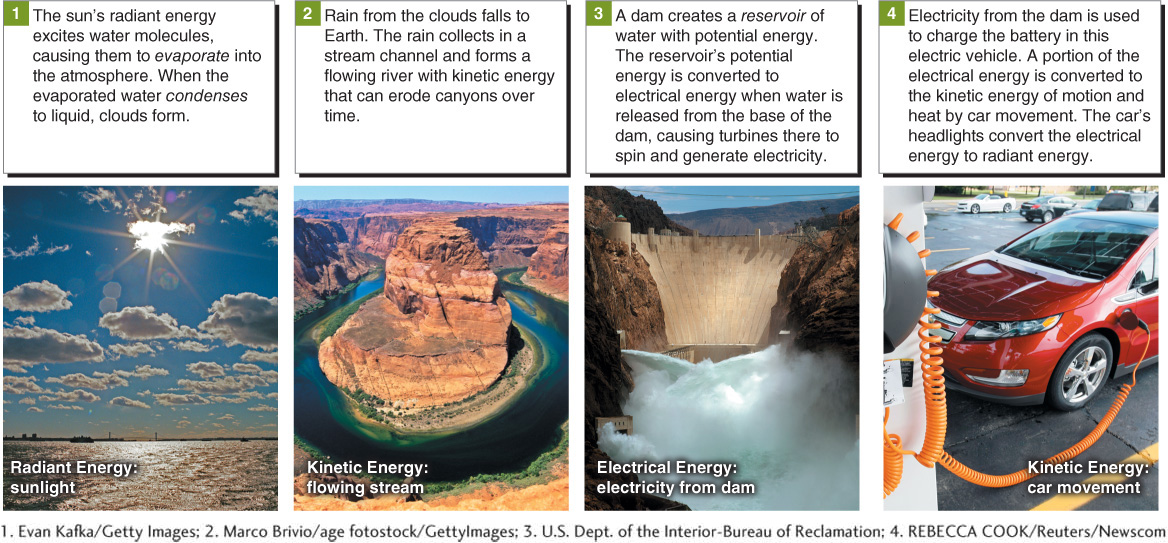
Earth’s Shape
From space, Earth looks like a perfect sphere, equal in all dimensions and perfectly smooth. Yet Earth is not a perfect sphere. Earth’s true shape results from distortion by Earth’s rotation, the vertical irregularities of Earth’s surface, and gravitational anomalies. As a result of these three factors, Earth is actually an oblate spheroid, a slightly flattened sphere with an uneven surface. For simplicity, however, Earth will be referred to simply as a sphere throughout this book.
Rotation
Earth rotates on an imaginary axis that runs through both poles. Due to its decreasing circumference from the equator to the poles, Earth’s rotation is fastest at the equator. Because the surface at the equator moves fastest, it bulges out more than other latitudes, and the planet flattens slightly at the poles (Figure GT.9).
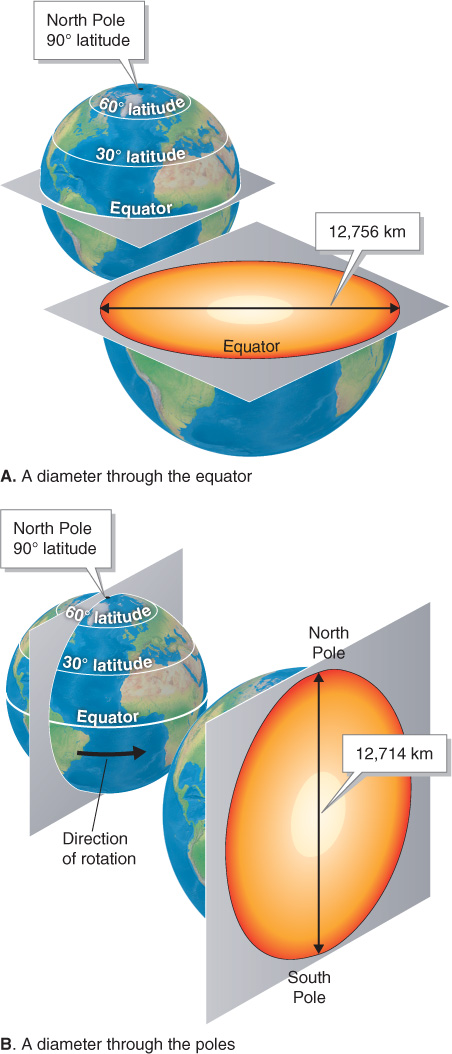
|
LATITUDE |
KM/H |
MPH |
|---|---|---|
|
0° |
1,670 |
1,037 |
|
30° |
1,447 |
899 |
|
60° |
837 |
520 |
|
90° |
0 |
0 |
Relief and Gravitation
Earth’s surface is folded and crumpled by geologic forces. From space, these folds and crumples are practically invisible. From the point of view of a human being on the ground, however, these surface features are dramatic. Relief is the difference in elevation between two or more points on Earth’s surface (Figure GT.10).
relief
The difference in elevation between two or more points on Earth’s surface.
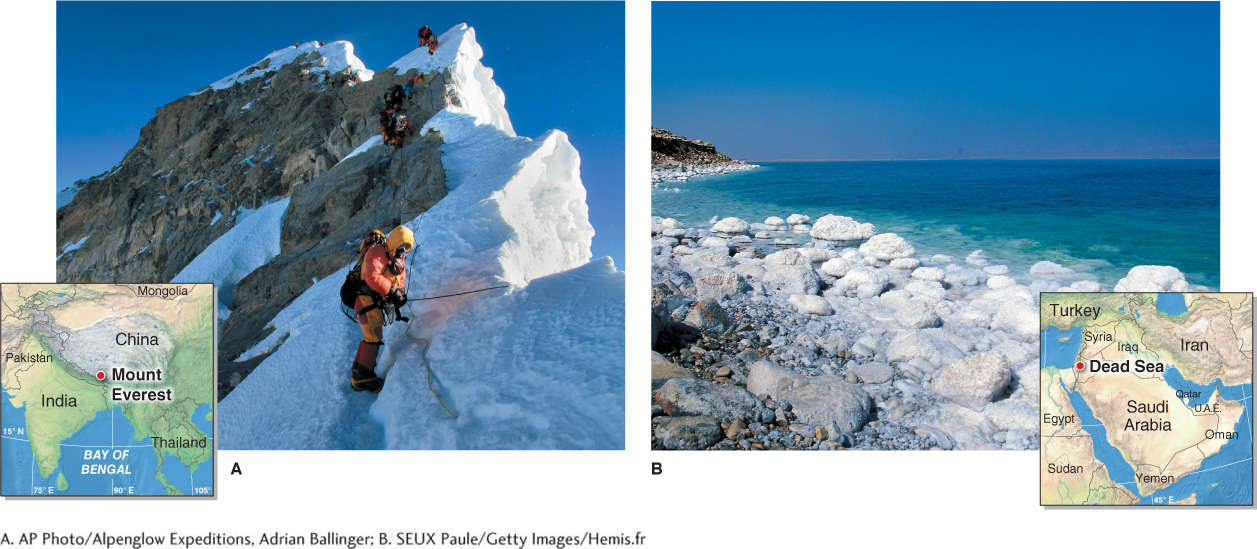
Earth’s shape sags and bulges as a result of its relief and as a result of differences in the thickness and mass of its crust, the rigid outermost portion of Earth’s surface. This unevenness causes different gravity fields across the surface. Mountains, for example, have more mass than valleys. As a result, gravity is stronger beneath most mountains than beneath most adjacent valleys. These irregularities of gravity change the elevation of Earth’s surface in relation to sea level by up to 100 m (330 ft) worldwide.
crust
The rigid outermost portion of Earth’s surface.
Earth Systems
One of the most important models in physical geography is the concept of physical systems. As we have seen, a system is a set of interacting parts or processes that function as a unit. A leaf, a tree, and a forest are each systems. The entire planet constitutes a system.
Energy and matter flow through Earth’s systems. Energy from the Sun and Earth’s internal geothermal energy do work on Earth’s systems and change matter within them. There are four main physical Earth systems: the atmosphere, the biosphere, the lithosphere, and the hydrosphere.
The Atmosphere
The atmosphere is the layer of gases surrounding Earth. It is composed of molecules and atoms that extend outward from the surface of Earth for hundreds of kilometers. It contains over a dozen different gases, but consists mainly of molecules of nitrogen (N2) and oxygen (O2). The atmosphere performs many functions crucial to life, which include providing oxygen for life and gases that block harmful rays from the Sun. The atmosphere also moderates temperatures on Earth’s surface, making life on land possible.
atmosphere
The layer of gases surrounding Earth.
The Biosphere
The biosphere is all of life on Earth. Humans are part of the biosphere. The biosphere extends from deep within the crust to high in the atmosphere. Far below ground in Earth’s crust live bacteria that are adapted to extreme pressure and heat. At 16 km (10 mi) above Earth’s surface, tiny fern spores and microscopic bacteria and pollen float on air currents above the continents and oceans. Most of the biosphere, however, can be found on the land’s surface and within the first few hundred meters of the surface of the oceans.
biosphere
All life on Earth.
The Lithosphere
We walk on, build our homes on, and grow our food on the lithosphere. The lithosphere is Earth’s rigid crust plus the heated layer beneath it down to about 100 km (62 mi). The lithosphere is fractured into 14 large plates (pieces) that slowly move, creating volcanoes, mountains, and earthquakes. The lithosphere also regulates and determines the atmosphere’s chemistry over time scales of millions of years through volcanic eruptions and the weathering of rocks.
lithosphere
The rigid outer layer of Earth, called the crust, and the heated layer beneath it down to about 100 km (62 mi).
The Hydrosphere
Compared with other planets, one unique characteristic of Earth is the quantity of its liquid water. Earth has immense liquid oceans, which cover 71% of the planet’s surface and are a little over 4 km (2.5 mi) deep on average. The hydrosphere encompasses all of Earth’s water in its three states: solid, liquid, and gas. It includes water in the oceans, in the ground, in organisms, and in the atmosphere as water vapor: water in its gaseous state. Water is also present in the atmosphere as clouds, which are composed mostly of liquid water. Water is present in, and plays roles in, the other three systems, so henceforth we will not treat the hydrosphere as a separate system.
hydrosphere
All of Earth’s water in its three phases: solid, liquid, and gas.
water vapor
Water in a gaseous state.
The Structure of Living Physical Geography
The material in this book is arranged in four parts, which focus on the work of solar and geothermal energy in the atmosphere, biosphere, and lithosphere. In Part I and Part II, we will see how solar radiant energy flows through the atmosphere and biosphere, transferring energy to the atmosphere and living organisms. In Part III, we will see how geothermal energy builds up the lithosphere. In Part IV, we will see how solar energy and gravity tear the lithosphere down through the work of flowing water (such as streams and coastal waves), ice, and wind (mainly in deserts). Figure GT.11 provides a visual diagram of the structure of this book.
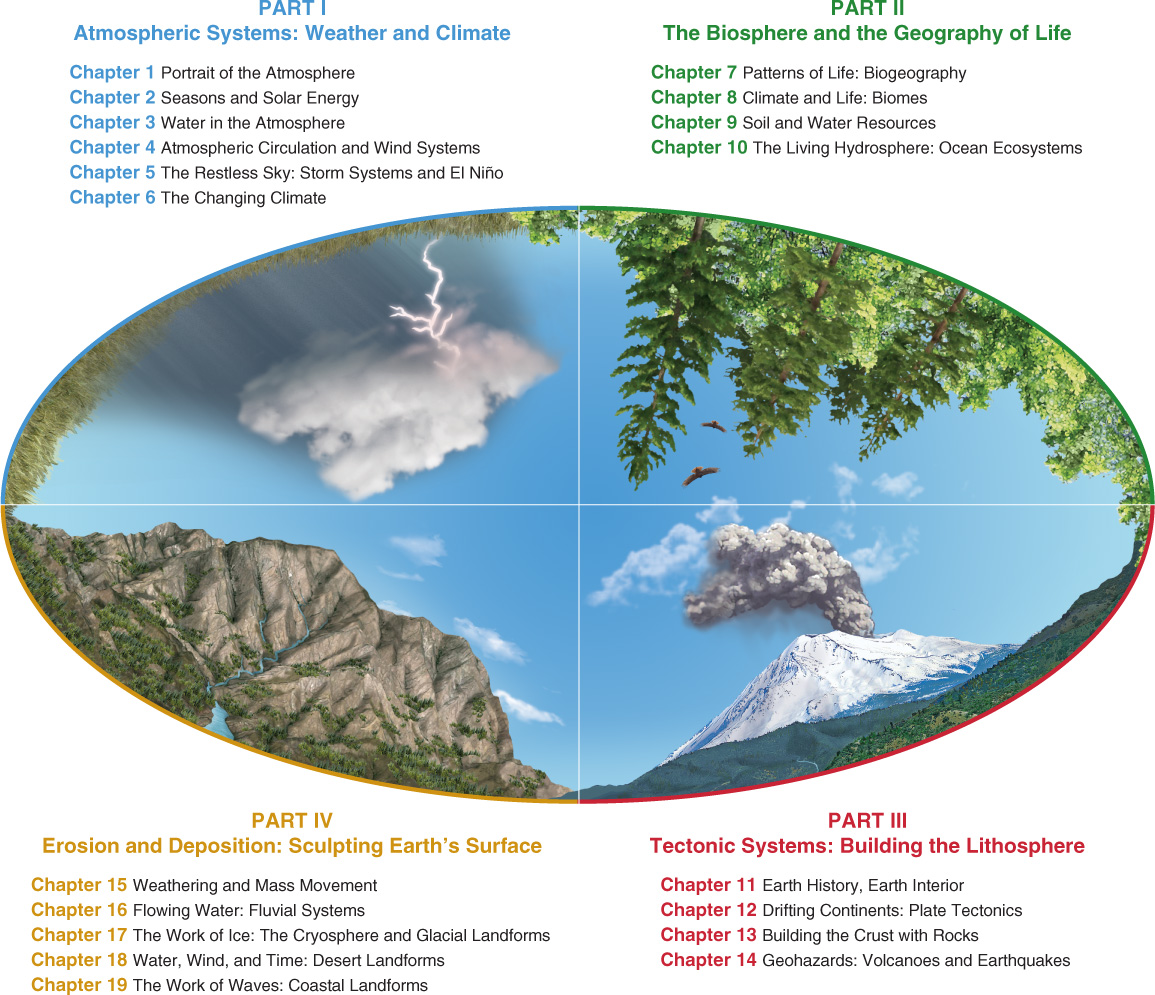
Part I: Atmospheric Systems: Weather and Climate
The Sun’s radiant energy flows through and does work on Earth’s physical systems. The Sun generates immense amounts of radiant energy. Some of this energy is intercepted by Earth.
Question 901.1
Where do tornadoes get their energy?
A tornado’s energy comes from the Sun’s heating of the atmosphere and from water that has been evaporated.
Solar energy interacts with and warms Earth’s atmosphere, land surface, and oceans. It sets the atmosphere in motion, creating weather and climate systems. Weather is the state of the atmosphere at any given moment and is made up of ever-
weather
The state of the atmosphere at any given moment.
climate
The long-
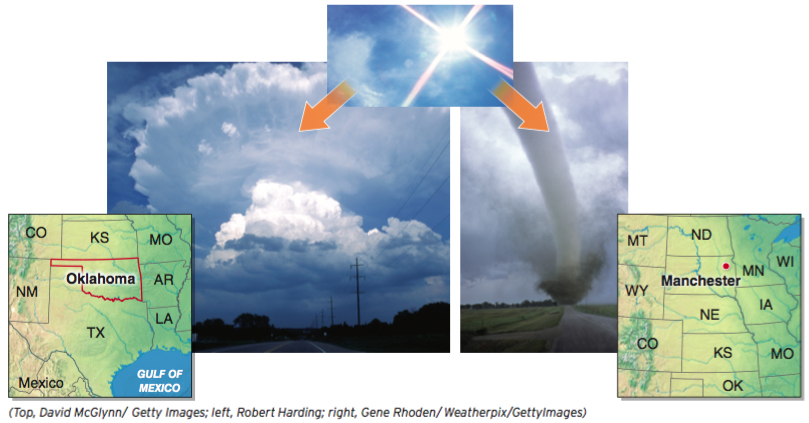
Part II: The Biosphere and the Geography of Life
Almost all life on Earth is a physical manifestation of solar energy. Solar energy enters the biosphere through photosynthesis. Energy created during photosynthesis is then transferred to all other living organisms through their food, as shown in Figure GT.13.
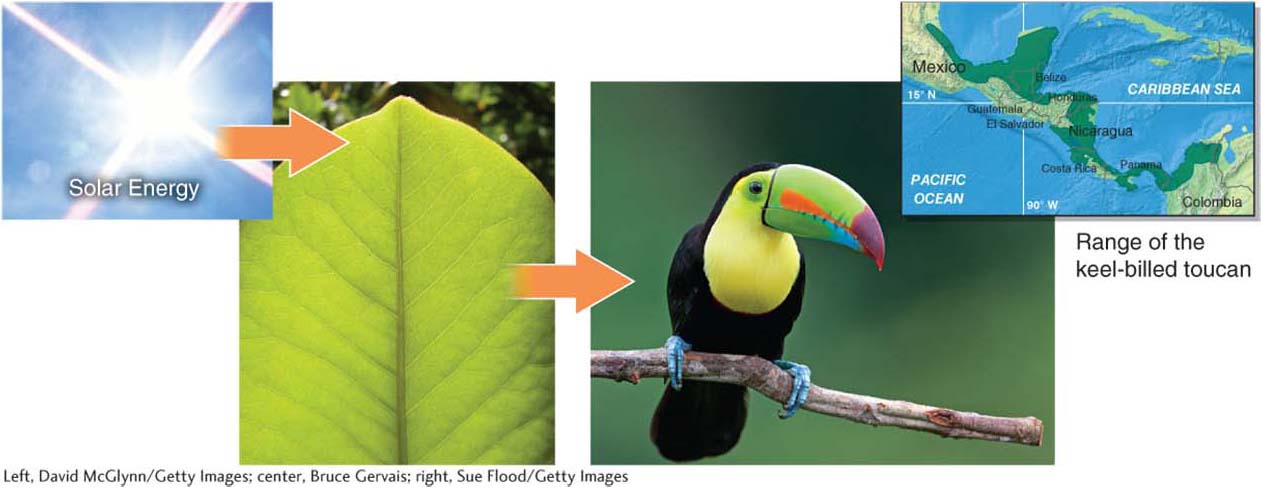
Part III: Tectonic Systems: Building the Lithosphere
The highest mountains and the deepest ocean trenches were built by Earth’s geothermal energy. Through the process of plate tectonics (see Chapter 11), geothermal energy grinds the plates of the lithosphere against one another, lifting and buckling mountains in the process and creating Earth’s surface relief. Plate movement also creates deep-
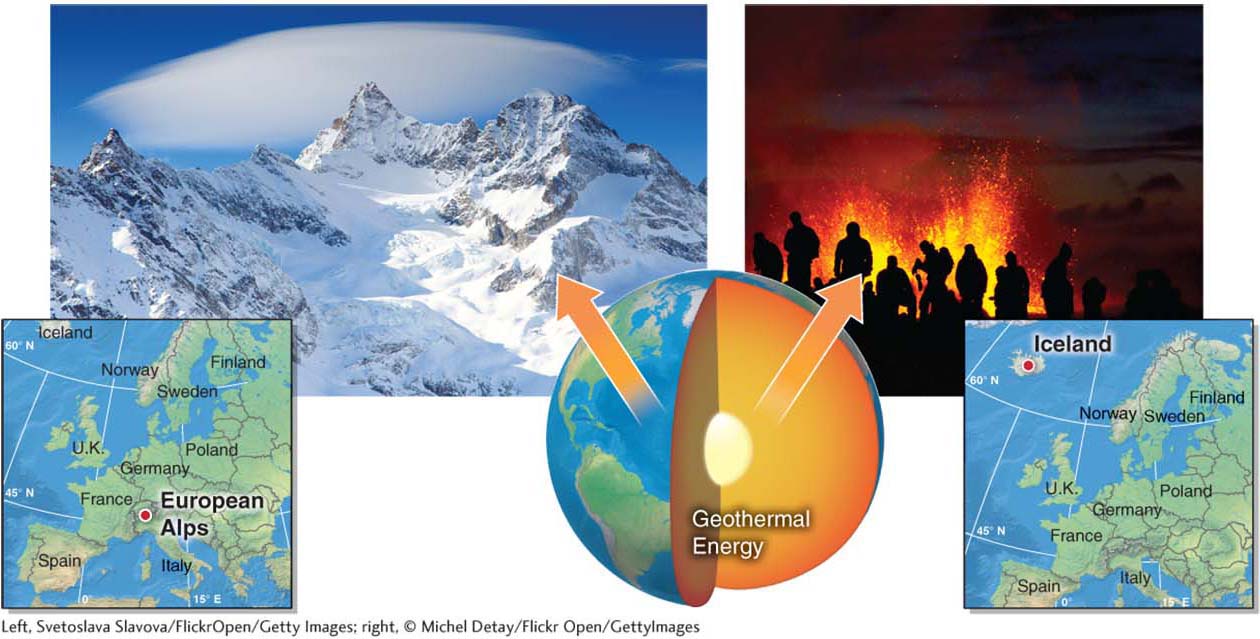
Part IV: Erosion and Deposition: Sculpting Earth’s Surface
As geothermal energy builds Earth’s relief, solar energy works to reduce relief and flatten Earth’s surface through erosion. Erosion is the process of transporting rock fragments via flowing water in streams and in coastal areas, in flowing ice in glaciers, and in blowing air in desert environments. Deposition is the process in which sediments that are transported through erosion accumulate on Earth’s surface.
erosion
The process of transporting rock fragments via moving water, ice, or air.
Evaporation is the process of turning liquid water to water vapor. Through evaporation, solar energy heats and lifts water from the ocean’s surface and moves it into the atmosphere. Through condensation (the process by which water vapor turns to liquid), the water returns to the continents as precipitation. Precipitation is falling rain, snow, sleet, or hail (see Section 3.5). Precipitation forms streams and glaciers that cut into the crust through erosion (Figure GT.15).
evaporation
The process of changing liquid water to water vapor.
condensation
The process of changing water vapor to liquid.
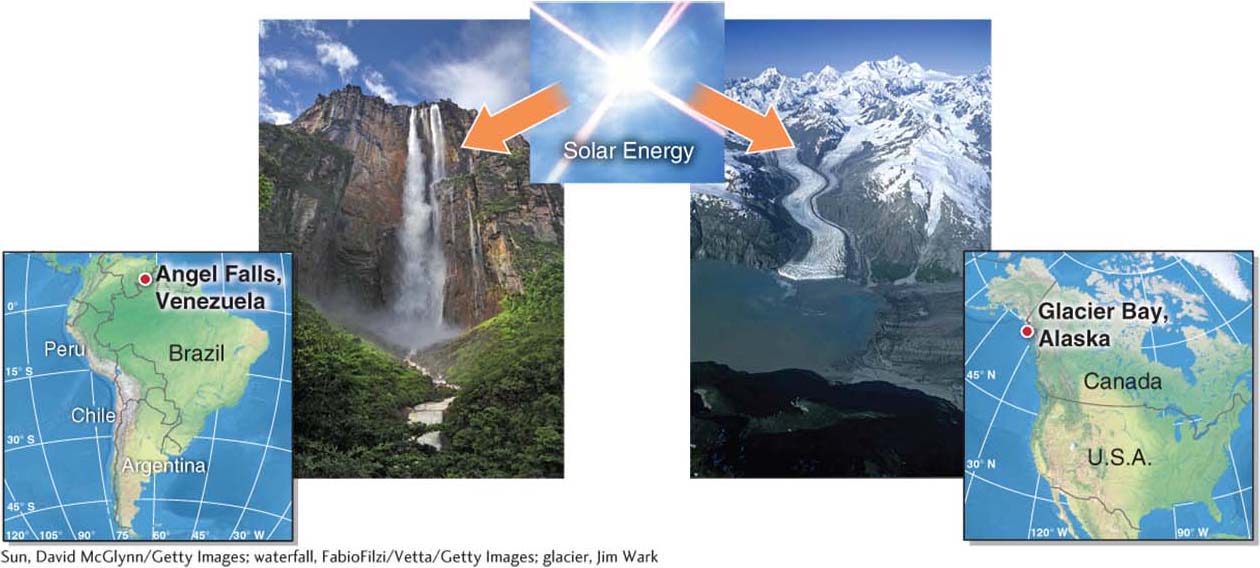
Over geologic time, rivers may carve deep canyons into plateaus that were uplifted by geothermal energy. Glaciers of flowing ice gouge and grind deep valleys (see Section 17.3). As long as the Sun is shining to evaporate water from the oceans, these erosive forces will be at work flattening out what geothermal energy works to build (Picture This).
Picture This
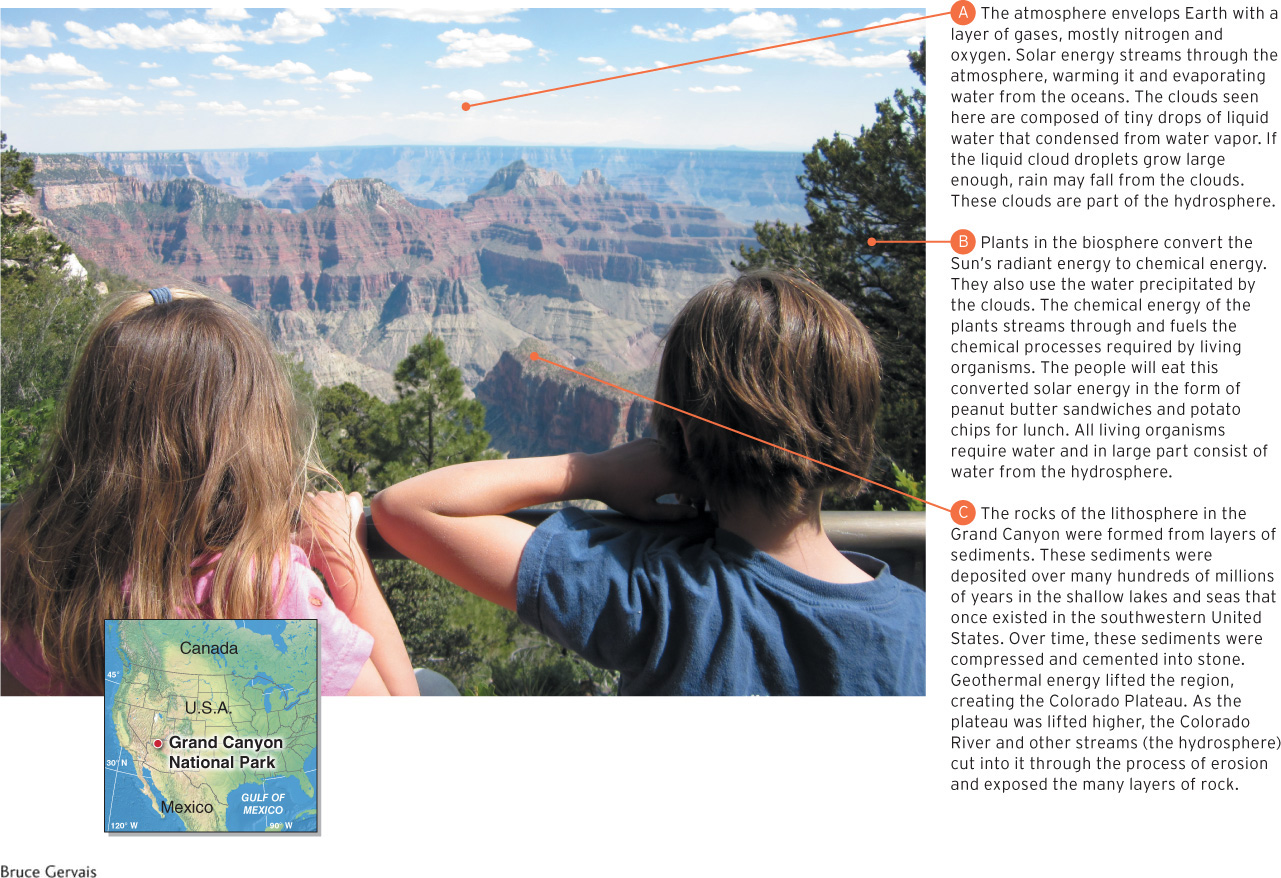
Living Physical Geography
This photo shows two vacationers overlooking the Grand Canyon in Arizona from the canyon’s North Rim. In most outdoor settings such as this, Earth’s physical systems are readily visible.
Consider This
Question 901.2
1. Give an example of how Earth’s physical systems overlap and interact with one another.
Question 901.3
2. Why is the hydrosphere so important to erosion of the lithosphere?
Question 901.4
3. Explain the following statement: “Animals (including people) are solar powered.”